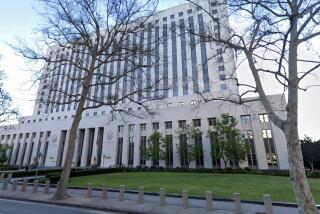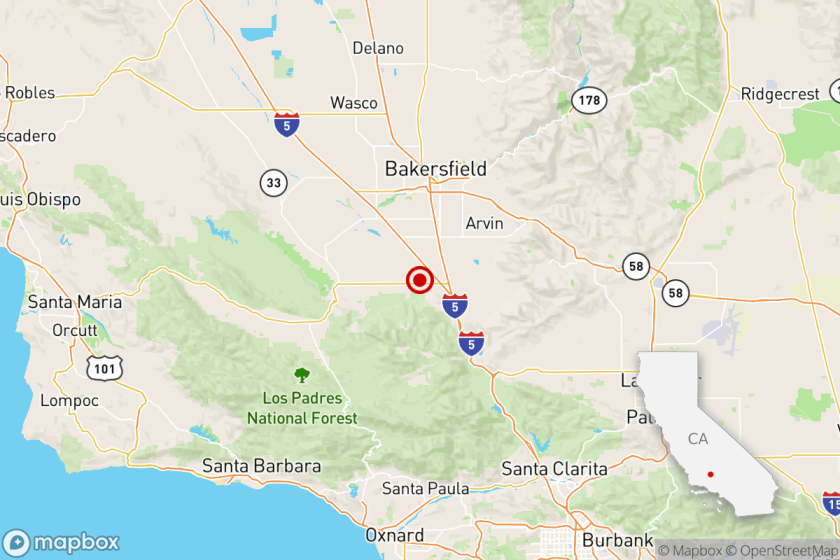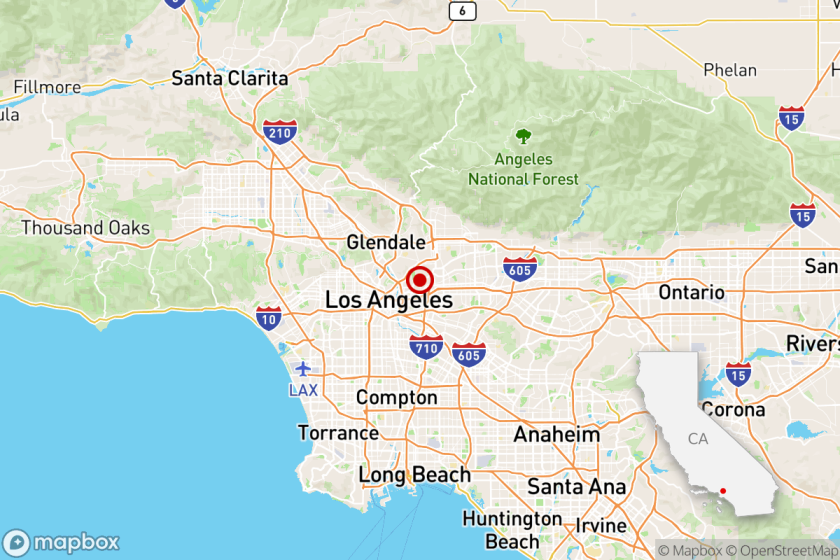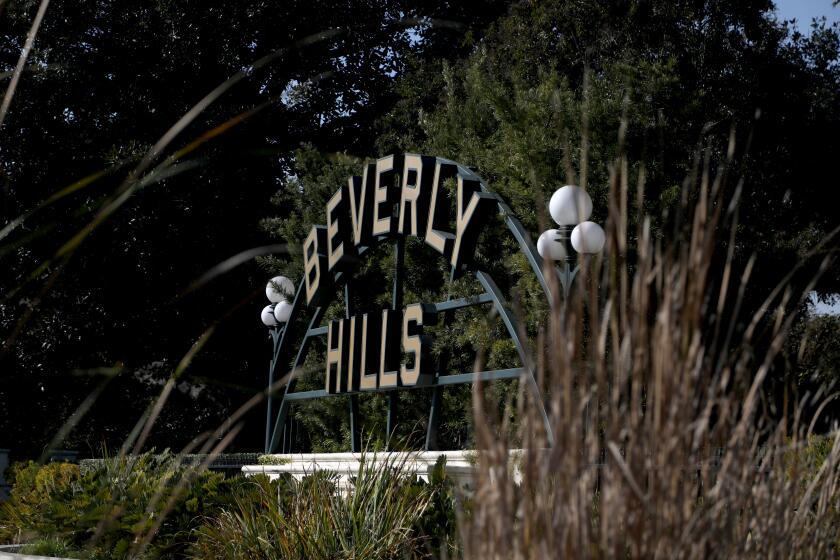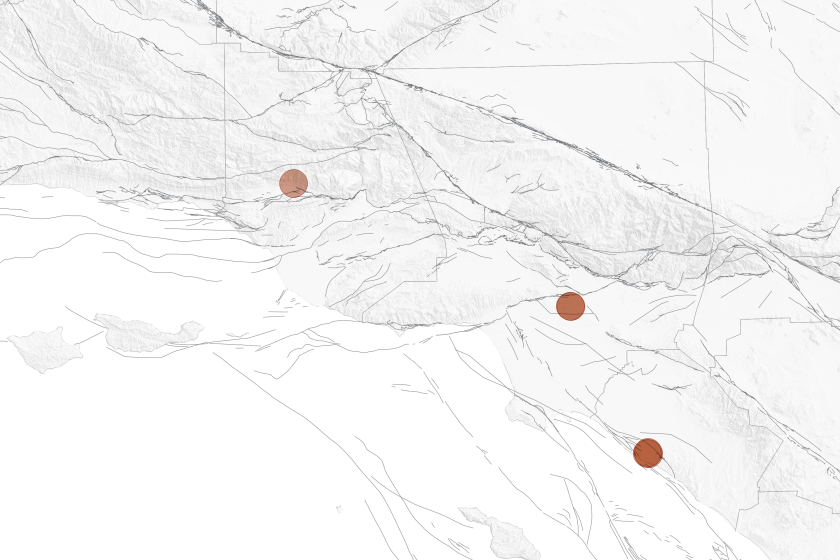Slow Motion Seismic Shake
For two years after the Northridge earthquake, a broad swath of the San Fernando Valley continued to surge slowly and imperceptibly upward in a displacement so large it eventually equaled a major earthquake.
Yet not so much as a teacup was rattled.
In all, the land east from Granada Hills to Simi Valley and north from Cal State Northridge to the Santa Susana Mountains rose almost half a foot, researchers at the Jet Propulsion Laboratory have calculated.
“The whole region continued to go up after Northridge,” said JPL geophysicist Andrea Donnellan.
“The amount of motion we have measured is equivalent to between a magnitude 6.0 and a magnitude 6.2 earthquake, but one that happened over two years . . . without damaging anything.”
The finding is the newest piece in a geophysical mosaic of Southern California created with the help of an expanding network of satellite sensors that continuously tracks Earth’s subtle movements.
The seismic portrait is of a city and a region on the move.
Much of the Los Angeles Basin is inching north, while the land between downtown Los Angeles and JPL in Pasadena is being squeezed together. Ironically, the laboratory itself seems to be veering off on its own tack, researchers have discovered.
In years past, the protracted disruption of the Earth’s crust detected by Donnellan and her colleagues might have gone unnoticed by even the most hypersensitive seismographs.
But since the 1994 Northridge quake, researchers have installed dozens of permanent satellite sensors so precise that they can pinpoint such shifts along Southern California’s fault lines to within a few thousandths of an inch.
The sensors are linked to a constellation of 24 orbiting satellites called the Global Positioning System, which allows anyone with the proper receiver to determine their position continuously with unprecedented accuracy.
At the time of the Northridge earthquake, there were only four permanent Global Positioning System stations in Southern California.
Today, there are 40, with researchers preparing to set up 80 more receiving stations in coming months.
Over the next three years, they hope to expand the regional network to a total of 250 permanent receiving stations.
*
Conceived originally for the Department of Defense about 20 years ago, the system has become ubiquitous in the civilian world, pressed into service by high-tech hikers as a navigation aid. System receivers are even turning up as a dashboard accessory in luxury rental cars.
But geophysicists are using the system to revolutionize their understanding of how the Earth moves.
It allows them to measure where the titanic stresses that cause earthquakes are building up along fault lines and how such stresses may be relieved harmlessly. It may be especially useful in monitoring the buried thrust faults that crisscross the Los Angeles region.
“We want to know where earthquakes are more likely or less likely and why,” said JPL geophysicist Michael Watkins, who, like Donnellan, is a member of the executive board that runs the new Global Positioning System seismic network.
“Because we are measuring the position of the GPS station every day, we can see how the ground is moving all the time. That will help us understand where strain is building up or where energy is being released aseismically, indicating a lessening of a hazard. We are talking about measuring the velocities to a millimeter per year or better,” he said.
The new insight into the slow-motion aftermath of the Northridge quake, reported in December at a meeting of the American Geophysical Union, is an example of how the satellite system is promoting a better understanding of the forces that feed earthquakes.
Researchers suspect such large, slow shifts may take place in the aftermath of every large earthquake.
The preliminary information suggests that some of the motion can be attributed to slippage along the fault zone itself, while some may be caused by shifts in the thick sedimentary deposits that cover it.
The movement may have reduced the threat of an earthquake along the faults underlying that part of the valley by reducing the tectonic strain on them. However, researchers said it was also possible that the strain simply shifted to nearby faults.
“It is not a huge, dramatic shift . . . but it is significant,” said Harvey Mudd College geophysicist Gregory A. Lyzenga, who is working on the JPL project.
“To us, what is interesting is that it forces us to confront the issue of how much deformation of the Earth we really know about and how much is going on behind our backs.
“In this case, the jury is still out whether this is good news, bad news or neutral,” he said.
*
The precision Global Positioning System surveys will be used to create maps showing how seismic strain is building up along fault lines and to better assess local earthquake hazards.
“Already, it is giving us a better handle on how the Los Angeles Basin is deforming,” said U.S. Geological Survey earthquake expert William H. Prescott in Menlo Park.
“This will be the first time we have had a dense enough coverage to really see the details of how the deformation is occurring.”
When the regional network is complete, only Japan will have a more comprehensive seismic monitoring system. In Japan, researchers are installing a thousand Global Positioning System stations to monitor virtually every seismically active area in the country.
To monitor seismic activity around San Francisco, researchers have set up 15 permanent stations.
In the Pacific Northwest, there are a dozen receivers. The New Madrid fault zone in the Midwest, which recently experienced a magnitude 3.8 earthquake, is being monitored by three receiving stations.
Indeed, the skewed motion of every one of Earth’s massive tectonic plates is now the subject of system monitoring, as geophysicists plot their speed and direction like state troopers clocking a speeding car with a radar gun.
An international network of 200 receiving stations is keeping track of the planet’s tectonic plates.
In Southern California, the stations are set up about six miles apart, usually in open fields or by parking lots.
Many are being placed near schools, so students can use the receivers in classroom experiments. JPL is collaborating with USC, the Southern California Earthquake Center and several school districts to develop a classroom exercise called “The Elastic Planet” that will allow students to use the system’s measurements.
The Southern California Integrated GPS Network, as the seismic system is formally called, received $2 million in 1996 from the National Science Foundation.
*
NASA and the U.S. Geological Survey each have contributed about $2 million. The Southern California Earthquake Center has added another $1 million.
Researchers are seeking foundation grants to complete the system.
“If we hope to make realistic assessments of earthquake potential in different parts of the Los Angeles Basin,” Lyzenga said, “we need to understand the processes and amounts of quiet movement, as well as the more obvious shifts that occur immediately during seismic events.”
(BEGIN TEXT OF INFOBOX / INFOGRAPHIC)
The Changing Landscape
Satellite sensors now allow researchers to measure earth movements along Southern California’s fault lines to within a few thousandths of an inch. Recent measurements show that the land east from Granada Hills to Simi Valley and north from Cal State Northridge to the Santa Susana Mountains has risen almost half a foot since the 1994 Northridge earthquake, according to Jet Propulsion Laboratory calculations. Meanwhile, the Los Angeles Basin as a whole has continued to inch northward, with the Palos Verdes Peninsula being squeezed a few millimeters closer to the San Gabriel Mountains.
POST-NORTHRIDGE VERTICAL MOTION (in centimeters)
* The earth has continued to move more than usual since the Northridge earthquake. This may mean that stress is being relieved, in part, without earthquakes, which may reduce the quake hazard.
VELOCITY O NORTHWARD MOVEMENT (milimeters per year)
* The Los Angeles Basin is being squeezed closed. Palos Verdes is moving toward JPL.
More to Read
Sign up for Essential California
The most important California stories and recommendations in your inbox every morning.
You may occasionally receive promotional content from the Los Angeles Times.
